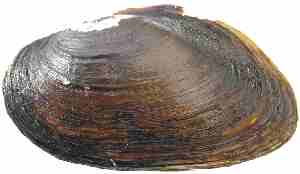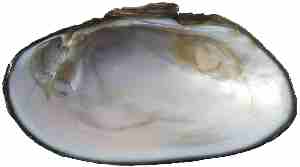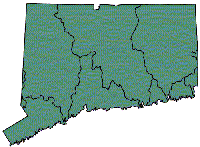Eastern Elliptio
Elliptio complanata
Key Features
Size: Up to five inches.
Shape: Highly variable, but most often subtrapezoidal or subovate. Valves heavy, strong, and laterally compressed.
Periostracum: Color tan (juveniles) to dark brown or black (adults). Shell rays may or may not be present.
Lateral Teeth: Present. Two on the left valve and one on the right valve.
Pseudocardinal Teeth: Present. Two on the left valve and one on the right valve.
Nacre: Color usually white, rose-colored, or purple, and is often discolored.
Often Confused With ... Eastern pearlshell or creeper. Rayed specimens may sometimes resemble eastern lampmussels.

External shell

Internal shell, right valve

Hinge teeth
 Habitat: The eastern elliptio is found in virtually any large pond, lake, stream, or river, where it is nearly always the most abundant mussel species. It can be found in all types of substrates.
Habitat: The eastern elliptio is found in virtually any large pond, lake, stream, or river, where it is nearly always the most abundant mussel species. It can be found in all types of substrates.
Range in Connecticut: Statewide.
Conservation: The eastern elliptio is the most abundant and widespread freshwater mussel in northeastern North America. Its ability to parasitize a variety of different host fish, inhabit both flowing and standing water, and withstand many forms of habitat disturbance and environmental pollution have made this species so common. It often greatly outnumbers all other mussel species, and may comprise the largest proportion of animal biomass in many lakes and rivers, often far exceeding the combined biomass of other invertebrates and fish. It is a staple food item for muskrats and otters.
Freshwater Mussel Fact Sheets
Eastern Pearlshell
Dwarf Wedgemussel
Triangle Floater
Brook Floater
Creeper
Eastern Elliptio
Eastern Floater
Alewife Floater
Eastern Pondmussel
Tidewater Mucket
Yellow Lampmussel
Eastern Lampmussel
The Freshwater Mussels of Connecticut
Content last updated on January 29, 2014.

